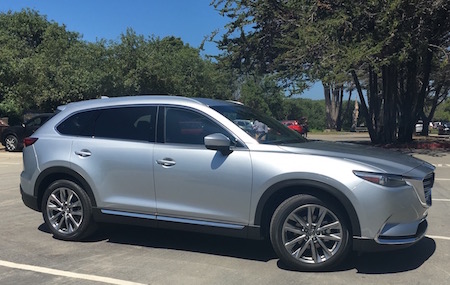New CX-9 Is Key In Mazda’s Attempt To Be Premium Brand
- May 24, 2016
- Mazda, New Model Introductions, On The Road: Driving Impressions
- Posted by George Peterson
- Comments Off on New CX-9 Is Key In Mazda’s Attempt To Be Premium Brand
This article appeared in Forbes Auto: May 23, 2016
Mazda has always been a brand different from most. It built its image on rotary engines that were fun to drive, but tough to make. Challenges from emissions and fuel economy regulations doomed the rotary early in the 21st century. Production ceased in 2012 with the demise of the Mazda RX-8 sports car. Mazda’s gorgeous Vision R coupe shown at the 2015 Tokyo Motor Show demonstrates Mazda hasn’t given up on the rotary, but admits only a small group of dedicated engineers are presently working on it. But the rotary engine is just part of the Mazda story.
The Ford Days to Independence From 1979 through 2009, Ford Motor had an increasing equity stake in Mazda Motor. Starting with 7% stake in 1979, Ford increased its position in Mazda until it had effective control with 33.3% of the company. Mazda and Ford teamed up on several car platforms where Mazda’s design expertise opened the eyes of Ford engineers to new more efficient techniques.
As the Great Recession deepened and Ford was struggling for liquidity, Ford divested its shares in Mazda and the company became independent in 2009. The result was a stand-alone brand with good products, but low volumes. In 2011, Mazda raised $1.9 billion to guarantee its future viability and develop its SkyActiv platform now underpinning its cars and crossover SUVs. With the introduction of the Mazda CX-9 crossover SUV in mid-2016, the transition to SkyActiv is complete.
For Mazda’s 2016 Fiscal Year, the company sold a bit over 1.5 million vehicles world wide and had a net income of ¥134 billion (~$1 billion). Prospects are even better going forward as Mazda entered a technology sharing agreement with Toyota in May 2015.
Repositioning “Zoom Zoom” to “Driving Matters” Now the stage is set for Mazda to reposition itself. In the United States, Mazda wants to be perceived as an upscale mainstream brand similar to Acura. Acura has always seemed like an upscale domestic brand (and not particularly successful), so this positioning may make sense.
One of the first things Mazda has done to facilitate this change is change its advertising tag line from “Zoom Zoom” to “Driving Matters.” “Zoom Zoom” has been around seemingly forever, since about 2000. At first, Mazda’s products did not live up to the “Zoom Zoom” tag line, so now that they do, the tag line is changed to a more mature “Driving Matters”. “Zoom Zoom” is still there, but in a secondary position to “Driving Matters”.
“Driving Matters” fits with the attitude that people who buy a Mazda product are more enthusiastic about driving than buyers of most other mainstream brands. Mazda does not want to sell an appliance – transportation from point A to point B – they want to sell a vehicle with an active, sporty driving experience that their owners embrace.
Mazda Vehicles Deliver More of a Premium Ambiance Along with repositioning the message, Mazda’s products have been achieving higher transaction prices at their dealers. Much of this results from selling a richer mix of vehicles with about 50% of the CX-5 being the upper middle Grand Touring model and the CX-9 having a projected 40% being the Grand Touring model (then combined with the Touring model, Touring plus Grand Touring are expected to be 70% of the CX-9 mix). No longer wanting to be a “cheap and cheerful” brand, Mazda will not be the cheapest in any segment. It wants to be best. Simply, the brand is chasing a better quality of business.
Pages: 1 2


